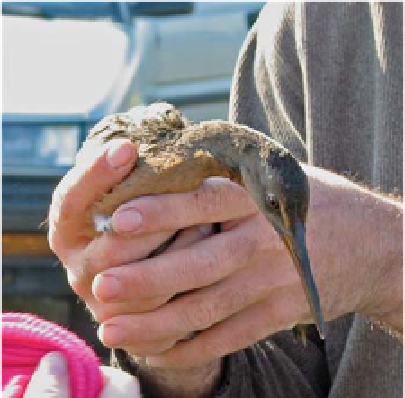Biology Reference
In-Depth Information
FIELDWORK: RAIL TELEMETRY
The clock claims it's the peak of the morning commute, but that's hard to judge at
Martin Luther King Jr. Shoreline Regional Park. The interstate and Oakland Interna-
tional Airport, just blocks away, emit a muffled rumble here, dampened further by
a pearl-grey ceiling of clouds.
I zip my windbreaker high against the mid-April chill and hurry to a boardwalk
overlooking a tidal marsh. There, Cory Overton, a wildlife biologist with the U.S.
Geological Survey, and his telemetry technician Jeffrey Lewis are observing Califor-
nia Clapper Rails. Overton is managing a survey of how and where these most en-
dangered of Bay Area birds move in the region's marshes. Known as Arrowhead
Marsh, this area offers a rare view of the largest and most human-acclimated pop-
ulation of these birds in the state.
Overton has a real fondness for California Clapper Rails. He says of these
stocky wetland residents, “Rails are basically chickens, and everything likes to eat
chickens—pretty much anything with teeth. But it's the same with the rails; they'll
eat anything they can get their beaks around.”
Earlier this year, Overton and his team of biologists conducted rail roundups at
four marshes. They captured eight birds at Arrowhead alone, outfitting each with
radio transmitters. The transmitters are the size of AAA batteries, worn between the
wings like a backpack and held in place by Teflon fabric straps.
Clapper Rails are caught by
hand and net. Biologists
band each bird, then at-
tach a radio transmitter
like a backpack between
the birds' wings. The radio
harness lasts about two
years. (Jude Stalker)
It's low tide and an ideal time to take location readings. Jeffrey takes out his
telemetry equipment. The set consists of a receiver that can detect the pings emit-
ted by the transmitters, a handheld antenna resembling an old TV aerial, and a set
of headphones. Modern electronics miniaturization hasn't affected this piece of
equipment; the sturdy metal receiver box, with seven dials and an LCD readout, is
the size of a car battery and weighs at least six pounds.



